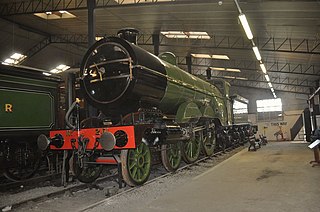
A locomotive booster for steam locomotives is a small supplementary two-cylinder steam engine back-gear-connected to the trailing truck axle on the locomotive or one of the trucks on the tender. It was invented in 1918 by Howard L. Ingersoll, assistant to the president of the New York Central Railroad.

The London and North Eastern Railway (LNER) Class V2 2-6-2 steam locomotives were designed by Sir Nigel Gresley for express mixed traffic work, and built at the LNER shops at Doncaster and Darlington between 1936 and 1944. The best known is the first of the class, 4771 Green Arrow, which is the sole survivor of the class.

The London and North Eastern Railway (LNER) Thompson Class B1 is a class of steam locomotive designed by Edward Thompson for medium mixed traffic work.

The Great Northern Railway (GNR) Small Boiler Class C1 is a class of steam locomotive, the first 4-4-2 or Atlantic type in Great Britain. They were designed by Henry Ivatt in 1897. In total 22 were built between 1898 and 1903 at Doncaster Works. The class were commonly known as 'Klondykes' [sic], after the 1897 Klondike gold rush. They could reach speeds of up to 90 mph. They were also known as Small Atlantics.

The London and North Eastern Railway Gresley Classes A1 and A3 locomotives represented two distinct stages in the history of the British 4-6-2 "Pacific" steam locomotives designed by Nigel Gresley. They were designed for main line passenger services and later express passenger services, initially on the Great Northern Railway (GNR), a constituent company of the London and North Eastern Railway after the amalgamation of 1923, for which they became a standard design. The change in class designation to A3 reflected the fitting to the same chassis of a higher pressure boiler with a greater superheating surface and a small reduction in cylinder diameter, leading to an increase in locomotive weight. Eventually all of the A1 locomotives were rebuilt, most to A3 specifications, but no. 4470 was completely rebuilt as Class A1/1.

The London and North Eastern Railway Class J38 was a class of steam locomotive designed for freight transport. They were designed by Nigel Gresley and introduced in 1926. A total of 35 were built at the LNER's Darlington Works in 1926 and they were used in Scotland. All passed into British Railways ownership in 1948 and they were renumbered from 5900–5934 to 65900–65934.

The Great Northern Railway 521 Class was a class of 0-6-0 steam locomotives, introduced in 1911. They were designed by Henry Ivatt for goods traffic. From 1912 to 1922 further examples, slightly modified by Nigel Gresley, were built and designated 536 Class. The most obvious difference was in the front sandboxes. These were below the running plate on the 521 but above it and merged with the front splashers, on the 536. The boiler and firebox were also moved back, thus resulting in a shortened cab. The London and North Eastern Railway classified them both as J6.

The North Eastern Railway Class S3, classified B16 by the LNER, was a class of 4-6-0 steam locomotive designed for mixed traffic work. It was designed by Vincent Raven and introduced in 1920. The earlier members of this class were fitted with Westinghouse Brakes - all of this equipment was removed during the 1930s.

The London and North Eastern Railway (LNER) Class K4 is a class of 2-6-0 steam locomotives designed by Nigel Gresley for the steep grades of the West Highland Line.

The London and North Eastern Railway Class U1 was a solitary 2-8-0+0-8-2 Garratt locomotive designed for banking coal trains over the Worsborough Bank, a steeply graded line in South Yorkshire and part of the Woodhead Route. It was both the longest and the most powerful steam locomotive ever to run in Britain. It was built in 1925 with the motion at each end being based on an existing 2-8-0 design. The original number was 2395, and it was renumbered 9999 in March 1946, and then 69999 after nationalisation in 1948, although it retained its cab-side plate bearing its original number throughout its life. The locomotive ran for some time as an oil burner, and was tried out on the Lickey Incline in 1949–1950 and again, after the electrification of its home line, in 1955. These trials were unsuccessful, and so the locomotive was withdrawn in 1955 and scrapped.

The LNER W1 No. 10000 was an experimental steam locomotive fitted with a high pressure water-tube boiler. Nigel Gresley was impressed by the results of using high-pressure steam in marine applications and so in 1924 he approached Harold Yarrow of shipyard and boilermakers Yarrow & Company of Glasgow to design a suitable boiler for a railway locomotive, based on Yarrow's design.

The London and North Eastern Railway (LNER) Class A8 was a type of 4-6-2T steam locomotive, designed by both Vincent Raven and Nigel Gresley. They were rebuilt from the LNER Class H1s, a 4-4-4T class.

The Great Northern Railway (GNR) Class C1 is a type of 4-4-2 steam locomotive. One, ex GNR 251, survives in preservation. Much like their small boiler cousins, they were capable of reaching speeds of up to 90 mph (145 km/h). They were also known as Large Atlantics.

The London and North Eastern Railway (LNER) Thompson Class L1 was a class of 2-6-4T steam locomotives designed by Edward Thompson. The prototype no. 9000 was built in 1945, but the remaining 99 were built under British Railways jurisdiction between 1948–1950. The prototype was well received, however the production batch were not, and all were withdrawn and scrapped between 1960 and 1962.

The GER Classes S46, D56 and H88 were three classes of similar 4-4-0 steam locomotive designed by James Holden and A. J. Hill (H88) for the Great Eastern Railway.

The London and North Eastern Railway Class P2 was a class of 2-8-2 steam locomotives designed by Sir Nigel Gresley for working heavy express trains over the harsh Edinburgh to Aberdeen Line. As they were to serve on Scottish expresses, they were given famous names from Scottish lore.

The Great Central Railway Class 8H was a class of 0-8-4T steam tank locomotives designed by John G. Robinson for hump shunting at Wath marshalling yard.

The London and North Eastern Railway Class A2/2 was a class of six 4-6-2 steam locomotives rebuilt by Edward Thompson in 1943 and 1944 from his predecessor Sir Nigel Gresley's P2 Class of 2-8-2 express passenger locomotives. The rebuilds improved reliability and reduced maintenance, but also suffered from a variety of issues during service, and all were withdrawn and scrapped between 1959 and 1961.
GCR Class 8G was a class of 10 two-cylinder steam locomotives of the 4-6-0 wheel arrangement built in 1906 for the Great Central Railway.

The NER Class Z was an Atlantic class of locomotives designed by Vincent Raven. It was introduced in 1911.



















